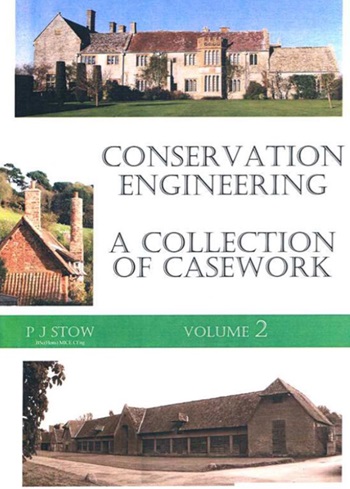Conservation Engineering: a collection of casework, Volume 2
Conservation Engineering: a collection of casework, Volume 2 P J Stow, Short Run Press, 2021, 608 pages, 32 cases, 450 photographs, more than 200 diagrams.
This second volume of a proposed three-volume series treats the reader to a further selection of the author Patrick Stow’s casework, spanning his 25 years as a conservation engineer. The projects here comprise mainly agricultural and smaller residential buildings in southwest England, many of them timber framed, with the distinction that they are mostly in the care of the National Trust. Some grander buildings are included, where the case focuses on a particular issue, such as at Montacute House, where visiting school parties marching in step along the Long Gallery had contributed to cracking in ceilings below, through the effects of resonance.
In this volume we find the same colour coded sections and pictogram index, cross referenced to both volumes and signposting the reader to cases involving elements of building structure; roofs, walls and floors are followed by chimneys and foundations. As Stow says, every problem is different, but the cases show what has been done before and may guide the approach to a similar problem.
Content is largely pre-digital and all the better for it. What sets this series apart is cases comprising real projects, hand drawn diagrams and sketches, photographs from the time and extracts from the project files, overlain with the author’s commentary, which reveals the evolution of thought. Stow’s work is characterised by simple, bespoke solutions but the reader is left in no doubt as to the amount of thought and understanding needed to achieve these. Lateral thinking results in logical economic repairs, sufficient to allow the original structure to continue to perform its role. Confidence is essential in conservation engineering to avoid heavy handedness. A helping hand is sometimes all that is necessary and many would learn from this approach.
Diagnosis in each study is comprehensive, demonstrating full understanding of the issues at play. A spreading roof and leaning wall at a 14th-century, open plan hall seemed alarming but are dealt with calmly, first by temporary strapping and a monitoring exercise, followed by a delicate repair scheme, justified by the results of further monitoring over a longer period. There is a section on temporary propping, often an important element in a repair scheme, described as ‘creation of a breathing space, likened to a well-earned cup of coffee’.
Stow’s sense of humour makes a technical tome a lighter read than it might have been and the format makes it easy to dip in and out of. The appendix is filled with useful information, including a section on crack monitoring. We learn about the characteristics of cracks in old buildings, which types of cracks are more serious and how their development can be assessed.
The author’s ambition is to pass on to the next generation some of what he has learnt over the years. This is done in a friendly and informative way, without being prescriptive and all the while encouraging the reader to keep an open mind. This volume can be enjoyed as a standalone work or if you already have the first it expands the projects available for reference. While a thought provoking read for any conservation practitioner, for an engineer looking to specialise in the field it should guide and inspire.
See also: Conservation Engineering: a collection of casework, Volume 1.
This article originally appeared as ‘Lateral thinking’ in the Institute of Historic Building Conservation’s (IHBC’s) Context 177, published in September 2023. It was written by Simon Malam, a conservation accredited architect at Donald Insall Associates.
--Institute of Historic Building Conservation
Related articles on Designing Buildings
IHBC NewsBlog
Old Sarum fire in listed (& disputed) WW1 Hangar - Wiltshire Council has sought legal advice after fire engulfed a listed First World War hangar that was embroiled in a lengthy planning dispute.
UK Antarctic Heritage Trust launches ‘Virtual Visit’ website area
The Trust calls on people to 'Immerse yourself in our heritage – Making Antarctica Accessible'
Southend Council pledge to force Kursaal owners to maintain building
The Council has pledged to use ‘every tool in the toolbox’ if urgent repairs are not carried out.
HE’s Research Magazine publishes a major study of the heritage of England’s suburbs
The article traces the long evolution of an internal programme to research 200 years of suburban growth
IHBC Context 183 Wellbeing and Heritage published
The issue explores issues at the intersection of heritage and wellbeing.
SAVE celebrates 50 years of campaigning 1975-2025
SAVE Britain’s Heritage has announced events across the country to celebrate bringing new life to remarkable buildings.
IHBC Annual School 2025 - Shrewsbury 12-14 June
Themed Heritage in Context – Value: Plan: Change, join in-person or online.
200th Anniversary Celebration of the Modern Railway Planned
The Stockton & Darlington Railway opened on September 27, 1825.
Competence Framework Launched for Sustainability in the Built Environment
The Construction Industry Council (CIC) and the Edge have jointly published the framework.
Historic England Launches Wellbeing Strategy for Heritage
Whether through visiting, volunteering, learning or creative practice, engaging with heritage can strengthen confidence, resilience, hope and social connections.















